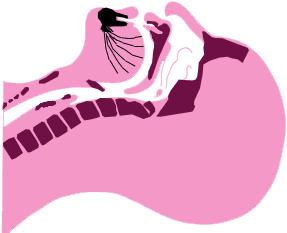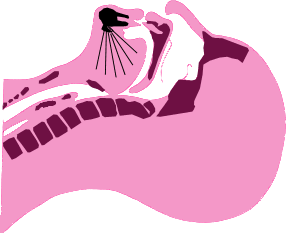Sleep apnea
|
|
Sleep apnea (alternatively sleep apnoea) is a sleep disorder in which breathing is interrupted during sleep. It is a kind of dyssomnia.
| Contents |
Obstructive sleep apnea (OSA)
Most people with sleep apnea have obstructive apnea, in which the person stops breathing during sleep due to airway blockage. Sufferers usually resume breathing within a few seconds, but periods of as long as sixty seconds are not uncommon in serious cases. It is more common amongst people who snore, who are obese, who consume alcohol, or who have anatomical abnormalities of the jaw or soft palate. However, atypical cases do occur, and the condition should not be ruled out unilaterally merely because the patient does not fit the profile.
"OSA" is caused by the relaxation of the muscles in the airway during sleep. Whilst the vast majority of people successfully maintain a patent (open) upper airway and breathe normally during sleep, a significant number of individuals are prone to severe narrowing or occlusion of the pharynx, such that breathing is impeded or even completely obstructed (Mortimore & Douglas, 1997). As the brain senses a build-up of carbon dioxide, airway muscles are activated which open the airway, allowing breathing to resume but interrupting deep sleep.
Recurrent airway obstruction gives rise to the obstructive sleep apnoea (OSA) syndrome, the most common category of sleep-disordered breathing, with 2% of female and 4% of male subjects meeting the minimal diagnostic criteria for OSA of at least 10 apneic events per hour. An "event" is characterised by complete closure of the upper airway for at least 10 seconds, wherein airflow is prevented despite continued respiratory efforts (American Academy of Sleep Medicine Task Force, 1999).


Patent airway vs. occluded airway (Bass, 2003)
These recurrent episodes of airway obstruction are associated with asphyxia, hypertension, depression, and daytime fatigue, since a transient interruption of the sleep cycle accompanies the restoration of airway patency. Most sufferers are not aware of these events, and are informed of the symptoms by their sleep partner. The apneic episodes are thought to account for the clinical sequelæ (symptoms that arise from a particular condition), which include increased incidence of chronic hypertension, a 700% rise in road traffic accidents, excessive daytime somnolence (similar, but unrelated to narcolepsy), social and family disruption, and cardiac arrhythmias and morbidity (Strollo, Jr. & Rogers, 1996). Obstruction of the upper airway may also be a cause of or may contribute to sudden infant death syndrome (SIDS) (Mathur & Douglas, 1994).
Diagnosis
In the past, the only way to diagnose the condition was in hospital, using a camera and other equipment to monitor sleep. With advances in portable electronics, patients may now use a small device that is strapped to a fingertip to measure the oxygen content of the blood, a procedure called pulse oximetry. This is a non-intrusive procedure because only the color of the finger need to be monitored. Recordings of blood oxygen saturation during sleep indicate the severity of the problem. The most accurate diagnostic tool, polysomnography, can confirm the diagnosis and assist the doctor in identifying the type of sleep apnea present, as listed below.
Excessive daytime sleepiness with no obvious cause, especially if the patient is overweight, is a primary indicator of possible sleep apnea. Apnea occurs most often in persons with a neck size of more than 17 inches. Apnea is more common among males than females, and tends to worsen with age.
Treatment
Physical Intervention
The most widely used current therapeutic intervention is positive airway pressure whereby a breathing machine pumps a controlled stream of air through a mask worn over the nose, mouth, or both. The additional pressure splints or holds open the relaxed muscles, just as air in a balloon inflates it. There are several variants:
- (CPAP), or Continuous Positive Airway Pressure, in which a controlled air compressor generates an airstream at a constant pressure. This pressure is prescribed by the patient's physician, based on an overnight test or titration.
- (BiPAP), or Bilevel Positive Airway Pressure, uses an electronic circuit to monitor the patient's breathing, and provides two different pressures, a higher one during inhalation and a lower pressure during exhalation. This system is more expensive, and is sometimes used with patients who have a higher than average CPAP pressure and/or who find breathing out against an increased pressure to be uncomfortable or disruptive to their sleep.
- (APAP), or Auto-titrating Positive Airway Pressure, is the most advanced form of such treatment. An APAP machine incorporates pressure and our vibration sensors and a computer which continuously monitors the patient's breathing performance. It adjusts pressure continuously, increasing it when the user is attempting to breathe but cannot, and decreasing it when the pressure is higher than necessary.
While the face mask makes some sufferers hesitant to try treatment, many patients find that the initial difficulty of adapting to the machine is quickly surpassed by improved, deeper sleep. The vast majority of patients are surprised to find that they tolerate the mask fairly easily and sleep well while wearing it. Despite their nature as "air compressors", modern CPAP machines are extremely quiet.
These treatments are often used with accompanying humidification, as some users experience a drying effect of the airway and mucous membranes. In the United States, these machines require a prescription. A sleep study is first done to determine what kind of treatment is needed, and to determine the proper settings for the nPAP device.
A second type of physical intervention, a dental device, is sometimes prescribed for mild or moderate sleep apnea sufferers. The device is a mouthguard similar to those used in sports to protect the teeth. For apnea patients, it is designed to hold the lower jaw slightly down and forward relative to the natural, relaxed position. This position holds the tongue further away from the back of the airway, and may be enough to relieve apnea or improve breathing for some patients.
Medical (pharmaceutical) treatment
Few drug-based treatments of obstructive sleep apnea are known despite over two decades of research and tests.
Oral administration of the methylxanthine theophylline (chemically similar to caffeine) can reduce the number of episodes of apnea, but can also produce side effects such as palpitations and insomnia. Theophylline is generally ineffective in adults with OSA, but is sometimes used to treat Central Sleep Apnea (see below), and infants and children with apnea.
In 2003 and 2004, some neuroactive drugs, particularly a couple of the modern-generation antidepressants including mirtazapine, have been reported to reduce incidences of obstructive sleep apnea. As of 2004, these are not yet frequently prescribed for OSA sufferers.
When other treatments do not completely treat the OSA, drugs are sometimes prescribed to treat a patient's daytime sleepiness or somnolence. These range from stimulants such as amphetamines to modern anti-narcoleptic medicines. The anti-narcoleptic modafinil is seeing increased use in this role as of 2004.
In some cases, weight loss will reduce the number and severity of apnea episodes.
Neurostimulation
Many researchers believe that OSA is at root a neurological condition, in which nerves that control the tongue and soft palate fail to sufficiently stimulate those muscles, leading to over-relaxation and airway blockage. A few experiments and trial studies have explored the use of pacemakers and similar devices, programmed to detect breathing effort and deliver gentle electrical stimulation to the muscles of the tongue.
This is not a common mode of treatment for OSA patients as of 2004, but it is an active field of research.
Surgical intervention
A number of different surgeries are often tried to improve the size or tone of the patient's airway. For decades, tracheostomy was the only effective treatment for sleep apnea. It is used today only in very rare, intractable cases that have withstood other attempts at treatment. Modern treatments try one or more of several options, tailored to the patient's needs.
- Nasal surgery, including turbinectomy (removal or reduction of a nasal turbinate), or straightening of the nasal septum, in patients with nasal obstruction or congestion which reduces airway pressure and complicates OSA.
- Tonsilectomy and/or adenoidectomy in an attempt to increase the size of the airway.
- Removal or reduction of parts of the soft palate and some or all of the uvula, such as uvulopalatopharyngoplasty (UPPP) or laser-assisted palatopharynsoplasty (LAUP). Modern variants of this procedure sometimes use radiofrequency waves to heat and remove tissue.
- Reduction of the tongue base, either with laser excision or radiofrequency ablation.
- Genioglossus Advancement, in which a small portion of the lower jaw which attaches to the tongue is moved forward, to pull the tongue away from the back of the airway.
- Hyoid Suspension, in which the hyoid bone in the neck, another attachment point for tongue muscles, is pulled forward in front of the larynx.
- Maxillomandibular advancement (MMA). A more invasive surgery usually only tried in difficult cases where other surgeries have not relieved the patient's OSA, or where an abnormal facial structure is suspected as a root cause. In MMA, the patient's upper and lower jaw are detached from the skull, moved forward, and reattached with pins and/or plates.
Central apnea
Another, rarer form is central sleep apnea, where a problem in the central nervous system (particularly the areas of the brainstem responsible for respiratory drive) interrupts breathing. Overdoses of opiates, such as heroin and morphine, kill by inducing a severe central apnea; these drugs are thus called "respiratory depressants". Central sleep apnea is more common at higher elevations.
A combination of Obstructive and Central Apnea is called Mixed Apnea.
Training apnea
(Training Apnea; informal suggestion for identification)
Noted amongst a minority of active free-divers, this is the case of subjects performing apnea while sleeping, generally coincident with a related dream. Some cases have been determined to last until the point at which diaphramatic contractions occur, and are estimated to be greater than one minute in length.
References
- Mortimore, I. L. & Douglas, N. J. (1997). Palatal muscle EMG response to negative pressure in awake sleep apneic and control subjects. Am.J.Resp.Crit.Care Med. 156, 867-893.
- American Academy of Sleep Medicine Task Force (1999). Sleep-related breathing disorders in adults: recommendations for syndrome definition and measurement techniques in clinical research. The Report of an American Academy of Sleep Medicine Task Force. Sleep 22, 667-689.
- Strollo, P. J., Jr. & Rogers, R. M. (1996). Obstructive sleep apnea. N.Engl.J.Med. 334, 99-104.
- Mathur, R. & Douglas, N. J. (1994). Relation between sudden infant death syndrome and adult sleep apnoea/hypopnoea syndrome. Lancet 344, 819-820.
- Slovis, B. & Brigham, K. (2001). Disordered Breathing. In Cecil Essentials of Medicine, ed. Andreoli, T. E., pp. 210-211. W.B. Saunders, Philadelphia.
- Bass GA. (2003). Respiratory Phase Sensitivity of the Upper Airway Negative Pressure Reflex and Superior Laryngeal Nerve Laterality in the Mediation of Upper Airway Motor Activity. Thesis Dissertation, National University of Ireland, Dublin.
External Links
- Sleep Apnea: Symptoms, Causes, Diagnosis, and Treatment (http://helpguide.org/aging/sleep_apnea.htm)
- Video from FOX6 News: San Diego company develops new technology to diagnose and treat sleep apnea (http://video.fox6.com/launcher/23472)
- Sleep apnea self-assessment quiz (http://www.sleepapneainfo.com/sleep-apnea_l2.php?id=91)
- Lungs Online - Sleep Apnea (http://www.lungsonline.com/sleep_apnea.html)
- Clinical and Alternative Treatment Options for Sleep Apnea (http://www.goldbamboo.com/topic-t2968-sleep_apnea.html)
- A worldwide listing of doctors certified by the American Board of Sleep Medicine (http://www.absm.org/Diplomates/listing.htm)
- Awake In America a national non-profit (U.S.) organization focused on sleep and sleep disorders, with the primary focus of helping establish community education and support groups throughout the United States. (http://www.AwakeInAmerica.org)de:Schlafapnoe-Syndrom
